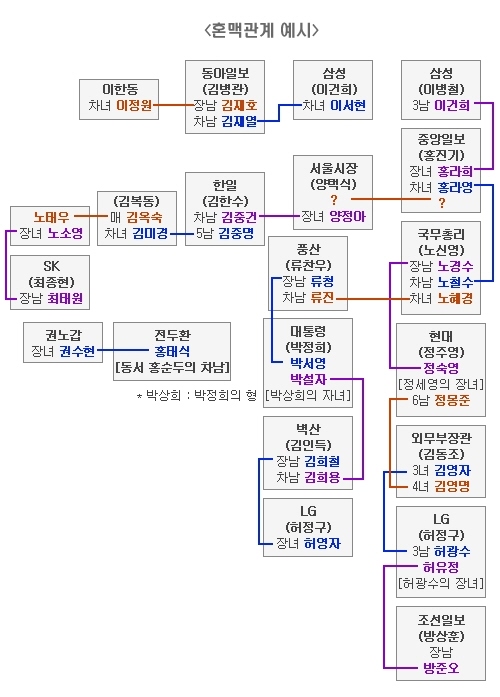(Family and Kin) Upper-class affinal relations
| Ch'amyôsahoe Yôn'guso ("Research Institute of Participatory Society") has charted out marital relations of the upper classes (or leading classes, chidoch'ûng). Affinal relations are centered around LG first and Samsung second, with newspaper as Chosun Ilbo, Joongang Ilbo and Donga Ilbo around there 한국 사회 상류층 혼맥(婚脈)의 핵은 LG그룹이 며 삼성그룹을 중심으로 조선.중앙.동아일보 등 언론 3사가 모두 연결됐다는 혼맥도 (婚脈圖)가 소개됐다. (In Daum News, from Yeonhap. Here's a short article of the survey in the Institute webpage; it'll be published in long form next week.) That the upper classes marry among themselves and other seek marital alliances with the powerful is nothing new, but it's very interesting (and important) to see these relations mapped out and brought to light, even if it'll sound like making pro-government research. "Ch'amyôsahoe Yôn'guso" sounds so much like the signboard of the present government (Ch'amyô chôngbu), added with the fact that the survey/research was introduced in the not exactly government-critical MBC program PD such'ôp with the topic "Upper class is the problem" (Chidoch'ûngûn munjeda); all the better that there was again a chance to present Chosun, Joongang and Donga in a negative light. But nevertheless, this is important research and very interesting for a student of Korean society and culture.  Here's some info about the research institution in question: Ch'amyôsahoe Yôn'guso is a research facility attached to the People's Solidarity of Participatory Democracy (Ch'amyô Yôndae), so at least the name precedes the present government. LG has affinal relations with a big number of other conglomerates, starting with Samsung in 1957. Others have been Hyundai, Daelim (대림, Doosan, Hanil, Hanjin, Keumho (금호) etc., and there are politicians' families involved as well. (LG그룹의 창업 일가는 1957년 삼성그룹과 혼사로 재벌간 사돈맺기의 효시 역할을 했고, 이어 현대.대림.두산.한일.한진.금호 등의 재벌가와 직접 사돈관계를 맺었 다. LG그룹은 실세 정치인들과도 사돈이 돼 상류층 혼맥의 큰 줄기가 됐다고 참여사 회연구소는 말했다) Lee Kun-hee (이건희) of Samsung married the oldest daughter of the Joongang chairman, and Lee's second daughter married the oldest son of Donga chairman. Former prime minister (국무총리) No Sin-yông married with a Hyundai woman, Former foreign minister Kim Tong-jo married an LG woman etc. In the 60s and 70s marriages between politicians' and tycoons' (재벌가) families were common, but later the chaebôls started marrying more between themselves, this especially after the late 90s economic crisis. (연령층별 재벌가의 혼인 상대를 보면 ▲20-30대는 정.관계 16%, 재계 60% ▲40 대는 정.관계 14%, 재계 37% ▲50대는 정.관계 23%, 재계 29% ▲60대는 정.관계 13%, 재계 26% 등이었다.) Marriages to non-upperclass persons among the conglomerate families are by age groups as follows: people in their 50s 33%, 40s 27%, 20s and 30s 13%. Some comparison with for example Japan would be interesting, for example to see if this trend of increasing in-marriage among conglomerate families finds equivalence. One explanation for this could also be that some of the conglomerates have been formed later, and chaebôl marriage partners were not available. But this is perhaps a weak explanation; there has been talk that the Korean social structure (or class structure, if you like) has been closing since the 1980s, and social mobility has been getting more difficult. Even thought this has not lead to a formation of for example a clear working class with a such an identity that would for example encourage offspring to seek factory employment instead of studying as far as resources allow, this shows that certain strata have seeked new ways (or better, utilized old ways) to assert their economic and political position. This is important especially in Korea, where the moral position of big money has always been weak, and in the manner of this PD such'ôp, even the marriage patterns are found to be a target of criticism (의무는 없고 특권만 있는 우리 사회 지도층). Perhaps it's necessary to add that the innûn nomdûl themselves have pretty heavily contributed to their negative image. (ADDITION) In the first presidential press conference this year (see " Hankyoreh), president Roh stated among other things that the "links of privilege" (특권적 유착) between politicians, media and economic circles (chaegye) shall be broken (haech'edoel kôt). Well, perhaps yuch'ak should be glossed with a more powerful and negative-sounding word than 'link', but I can't think what it'd be. I don't know if this statement and the publication of the marital link study yesterday is just 烏飛梨落, but people with tendency to suspect this (or any other Korean) government would think that it's not. Categories at del.icio.us/hunjang: family/kin • Koreaneconomy • Koreansociety • stratification |


Comments to note "(Family and Kin) Upper-class affinal relations" (Comments to posts older than 14 days are moderated)
Write a Comment